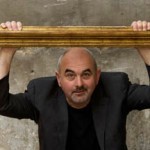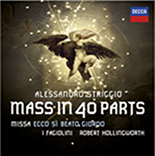Gawain Glenton and Rebecca Austen–Brown
Seven participants write about ‘their’ recording.
Eamonn Dougan (baritone)
 A fifth recording of Spem in Alium for me, but this being I Fagiolini, I knew it would be different. When I was a student at the Guildhall School of Music and Drama I had a fantastic coach, Mark Shanahan, who had a way of turning things on their head so that you approached whatever you were singing from a point of view that you hadn’t considered before. This is how Robert often works – finding a different angle: not just to be different or for effect, but so performers and audience see and hear pieces in a new light. When I learned that Spem would not be the centrepiece of the disc, but would complement Striggio’s colossal Ecce beatam lucem and the lost 40-part mass, I knew it would be a fascinating few days.
A fifth recording of Spem in Alium for me, but this being I Fagiolini, I knew it would be different. When I was a student at the Guildhall School of Music and Drama I had a fantastic coach, Mark Shanahan, who had a way of turning things on their head so that you approached whatever you were singing from a point of view that you hadn’t considered before. This is how Robert often works – finding a different angle: not just to be different or for effect, but so performers and audience see and hear pieces in a new light. When I learned that Spem would not be the centrepiece of the disc, but would complement Striggio’s colossal Ecce beatam lucem and the lost 40-part mass, I knew it would be a fascinating few days.
Robert had talked me through his plans for how to voice the various choirs while we were working together a few months before the recording. Variety of colour and texture seemed to be the primary aim, but also clarity of text – no easy task in a 40 part texture. This wouldn’t be a traditional rendition with a purely vocal texture but ‘choirs’ of one voice with viols, two voices with brass, mixed wind doubled by voices – a broad palette with which to play, but hopefully one in which the text could be kept clear and audible to the listener. There were also smaller-scale madrigals and instrumental works, the scoring for each beautifully thought out, giving the recording a wonderfully rich aural landscape.
So we all converged on All Saints, Tooting in late September. It felt somewhat like a musical meeting of the clans – members of Fretwork, the Rose Consort of Viols, the English Cornett & Sackbut Ensemble and singers from a number of generations, all gathered under the Fagiolini umbrella and the baton (he did use one for such an extended gathering) of Robert.
We recorded all the large-scale pieces in the round. What a delight to be able to follow the music aurally and visually as it passed around the circle of musicians (this works majestically on the DVD surround-sound version). Robert, in the middle on a rostrum, was in total control and having the time of his life. He repeatedly urged us to work harder at the colours, to nurture the text – to stretch ourselves musically and revel in this unique opportunity. There was a tremendous sense of endeavour and everyone pulling in the same direction. Certain performances stood out: Grace Davidson’s flawless treble singing, take after take: cornet player Dickie Thomas showing incredible sensitivity and perfect technique when doubling a vocal line, and Erin Headley, a total legend, playing the notoriously difficult lirone with effortless style and grace.
Our four-month-old son came along to listen and see his parents at work. He won’t remember it, but in years to come I’ll be able to play him what should be an outstanding recording and tell him “You were thereâ€.
Richard Boothby (viol)
There’s really nothing like being one part of 60. Playing in a large orchestra is the closest thing, I suppose, performing something like a Mahler symphony, or a Wagner music drama; but, actually, in those cases you would be not one of 60 parts, but one of many players. Even these complex works of the late Romantic period rarely attain more than 10 or 12 real parts. To play a single contrapuntal line, along with fifty-nine others, is an exhilarating, once-in-a-lifetime experience that few have had. I feel privileged to have had that chance.
Of course, Fretwork play contrapuntal music of the 16th and 17th centuries all the time, and 6 parts is normally our maximum. It’s usually quite enough, and being part of a fantasia by Gibbons, Byrd, Lawes or Jenkins in six parts is a wonderful and involving musical experience that is as complete as one can imagine – but the soundscape of 60 parts is something quite different. Eventually, every space in the aural spectrum is filled with sound and one becomes part of a gently undulating, throbbing sonic beast. It’s the sort of thing Phil Spector was looking for in the 1960s, but never achieved.
Sally Dunkley (soprano)
 How does one begin to describe this extraordinary week? The outcome of Robert Hollingworth’s painstaking planning and preparation, of course, and of individuals’ kind generosity (it was nice to be able to chat with the sponsors who came along to listen – and also brought those irresistible home-made cake).
How does one begin to describe this extraordinary week? The outcome of Robert Hollingworth’s painstaking planning and preparation, of course, and of individuals’ kind generosity (it was nice to be able to chat with the sponsors who came along to listen – and also brought those irresistible home-made cake).
In the event, it proved to be a week of uniquely exciting music-making in which a gathering of like-minded people delighted in the practical discovery of what is surely the most significant musicological find for several decades. But there was much more to it than that: a rare collective frisson and a sense that this was something very special indeed, a crazy venture that was determined to prove itself a world-beating success. The adrenalin was catching, and afterwards it took me days to come down to the ordinary world.
Listening to the 2007 Prom performance of Striggio’s Mass on a small radio hadn’t prepared my ears for the bright colours that erupted from this reading, editorially scored up – on good historical performance practice – with a kaleidoscopic variety of solo voices combined with instrumental consorts of strings, winds loud and soft, and pluckers, lots of them (I’m still pondering the collective noun for four Renaissance lutes – never had cause to use it before).
Most memorable, for me, was listening to the breathtakingly cool singing of some of my soprano colleagues, luminous in tone and exquisitely phrased, the embodiment of particular ideals that I have long cherished.
And what of Tallis’s Spem in alium, always a memorable happening, musically and socially? It’s been a constant part of my life both as singer – eight recordings – and as editor – many days spent poring over the early 17th-century manuscript in the British Library that preserves the English-texted version Sing and glorify, sung as part of BBC Radio 3’s celebrations of the 1982 royal wedding. This time round Hugh Keyte, who had produced that historic programme, made a thorough and long overdue re-examination of the score, resulting in some audible differences, and his speculations about its original spatial presentation opened up our imaginations to a vivid world of Elizabethan stately entertainment in which no expense was spared
Lynda Sayce (lute)
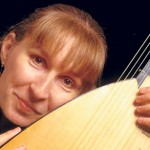 Four somewhat bemused Renaissance lutenists were involved in this Striggio recording – bemused partly because we couldn’t believe our luck to be involved in such an extraordinary project, and partly because it didn’t feel anything like a conventional lute recording, typically an intimate and often solitary endeavour. For starters, the venue was packed with musicians, some of them bearing very loud instruments which are not traditionally associated with lutes – shawms, sackbuts, and the like. Secondly, the church where we recorded was a far cry from the typical lute venue, where absolute silence is required to capture the gossamer sounds of the instrument without too many extraneous noises. Instead of splendid isolation and rural sounds safely blocked out by impressive thicknesses of medieval stonework, we were surrounded by the robust and distinctly un-Renaissance bedlam of Tooting, complete with sirens, helicopters, and excited footballers in the car park. Tuning up required the tactical discipline of an army on the move, and prior to each session the building sported a lutenist huddled in every corner with their digital tuner of choice.
Four somewhat bemused Renaissance lutenists were involved in this Striggio recording – bemused partly because we couldn’t believe our luck to be involved in such an extraordinary project, and partly because it didn’t feel anything like a conventional lute recording, typically an intimate and often solitary endeavour. For starters, the venue was packed with musicians, some of them bearing very loud instruments which are not traditionally associated with lutes – shawms, sackbuts, and the like. Secondly, the church where we recorded was a far cry from the typical lute venue, where absolute silence is required to capture the gossamer sounds of the instrument without too many extraneous noises. Instead of splendid isolation and rural sounds safely blocked out by impressive thicknesses of medieval stonework, we were surrounded by the robust and distinctly un-Renaissance bedlam of Tooting, complete with sirens, helicopters, and excited footballers in the car park. Tuning up required the tactical discipline of an army on the move, and prior to each session the building sported a lutenist huddled in every corner with their digital tuner of choice.
Once playing, there were decisions about the sizes of lute; between us we had instruments in a’, g’ and a big bass lute in d’, all of which were routinely used for ensemble music in the 16th century. I found myself playing all three sizes in different sessions, transposing according to need. Equipping us with something from which to play turned out to be a logistical nightmare. Striggio’s huge score has very few bars on each page, and page-turning whilst playing a lute is a frustrating exercise, replete with rustling noises, curses and inadvertent cascades of paper. After much pre-session discussion, we were all provided with short scores for our individual choirs, and we played a sort of proto-continuo part for that choir, filling in the bass, sometimes doubling a particularly interesting line, or sketching in as much of the texture as would fit on the instrument. In the first rehearsal it became obvious that such simple, literal doubling would have little audible effect, so we began to embellish those parts, eventually arriving at an exuberant filigree of improvised diminutions, sprinkled over the piece like icing sugar on a large and sumptuous cake. We know from many written sources that this is what the lute – and most instruments – did in such situations, but opportunities to try it today are very rare; budgets are usually too tight and personnel too limited to spare anyone for such an ornamental role (the last time I did this was in Monteverdi’s ballo Tirsi e Clori with I Fagiolini). However, it worked and the result can (apparently) be heard to effect, notably in certain softer passages! As the lute team dispersed – perhaps never to reconvene – I’m sure we all felt that we had experienced a new and exhilarating way of using our instruments.
Gawain Glenton (cornett)
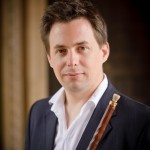 When I walked into the church for the first rehearsal there were so many people around I thought Robert had been taken over by the ghost of Cecil B. DeMille. After all, such a large group of cornett and sackbut players on a single project would normally steal the show (at least we like to think so), but with the numbers involved in this recording, even the nine-strong contingent from the English Cornett and Sackbut Ensemble made up just a fraction of the total forces.
When I walked into the church for the first rehearsal there were so many people around I thought Robert had been taken over by the ghost of Cecil B. DeMille. After all, such a large group of cornett and sackbut players on a single project would normally steal the show (at least we like to think so), but with the numbers involved in this recording, even the nine-strong contingent from the English Cornett and Sackbut Ensemble made up just a fraction of the total forces.
The parts we were given in the Striggio Mass were of course vocal lines, so our job was to ‘play the text’ as much as possible. In the 16th century, cornetts and sackbuts were constantly used to support or replace singers because they sounded so similar to the human voice. While we can’t produce actual words with our instruments, we still aim to phrase the music as closely as possible to the text, reproducing the accents and rhythms to match the singers.
As cornett players we also tried to emphasise some passages with ornaments, trying to add a little icing on the cake here and there, just as our 16th-century predecessors might have done. If the text suggested it, we would perhaps try to think of a nice running ornament that finished an octave higher, while listening to check we weren’t ruining someone else’s big moment. Our priority, however, was always to play as vocally as possible, letting the impact come from the monumental scale of the music.
Mark Dourish (tenor)
 As a lifelong fan of Renaissance sacred music I was absolutely thrilled (and very honoured) to be asked to take part in this world premiere recording as one of the additional singers for the huge final Agnus Dei. Thank heavens for the world tenor shortage! I’d long been an admirer of Robert’s work and had had great fun working with him several times in the amateur setting. This was going to be something very different, though.
As a lifelong fan of Renaissance sacred music I was absolutely thrilled (and very honoured) to be asked to take part in this world premiere recording as one of the additional singers for the huge final Agnus Dei. Thank heavens for the world tenor shortage! I’d long been an admirer of Robert’s work and had had great fun working with him several times in the amateur setting. This was going to be something very different, though.
Arriving at the sessions in September, it was hard not to feel a little star-struck. So many famous faces! So many famous voices! The recording sessions were focused and efficient but also thrilling and enormously enjoyable. Quite frankly, sitting in the middle of this world-class ensemble being enveloped by the sound of 40 of my musical heroes really going for it is something that I’ll never forget. If the engineers have caught even a fraction of that excitement and that amazing sound then this CD will be an absolute winner.
Adrian Hunter (producer)
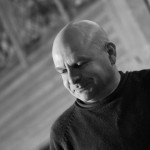 Having thought, planned and theorized with Robert for many weeks beforehand, it was something of a relief simply to walk into All Saints Tooting and find, already there, what felt like a mini-Colosseum consisting of many of one’s performing colleagues from the past two decades.
Having thought, planned and theorized with Robert for many weeks beforehand, it was something of a relief simply to walk into All Saints Tooting and find, already there, what felt like a mini-Colosseum consisting of many of one’s performing colleagues from the past two decades.
The atmosphere in the sessions was remarkable. Given the potential for things to come unstuck, and the need to adhere to a schedule, it could have been a dauntingly workmanlike process; but Robert’s abundant energy, unfailing encouragement and determination to realise particular aspects of interpretation meant that a cheerful sense of ambitious achievement prevailed.
An abiding memory for me; the scores were enormous – and because any part might suddenly draw attention to itself, my eyes would be chasing up and down the page seeking to locate it. But by the time I had, everybody is several bars ahead, probably over the page, and something else noteworthy is already happening…
(Photo of Adrian Hunter by Stefan Schweiger)
Buy your copy!
- I was thinking that. Also @JolyonMaugham was (which carries a little more weight). https://t.co/pAu9emYdGd
- For my birthday I have done admin, walked dog, and rehearsed Walton with @The24choir https://t.co/jNTU2B3UIw https://t.co/LDhso8U9jS
- It's very reasonably priced and all those benefits.... https://t.co/DFJS8e9Dqw
